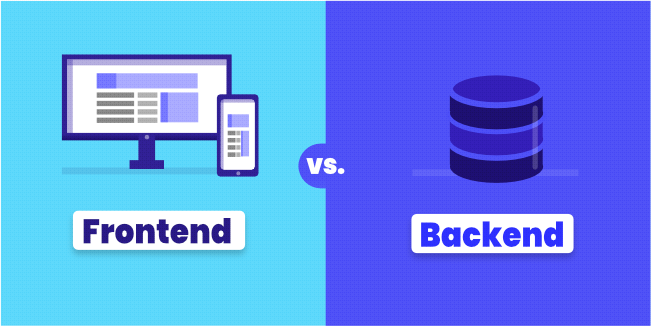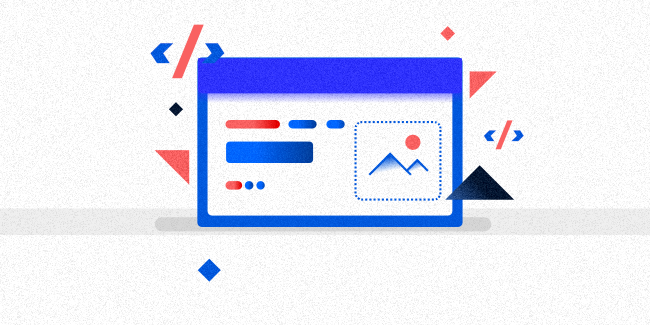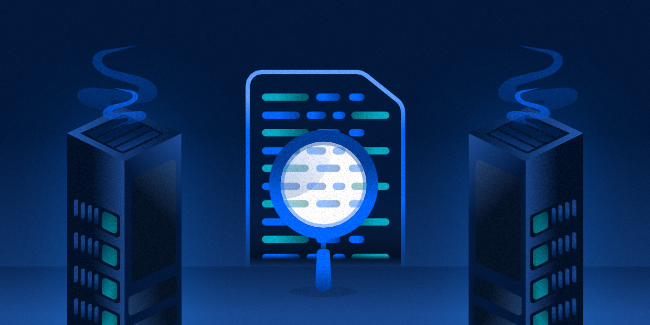webdevelopment
fullstack
backend
frontend
Frontend vs. Backend - What is what?

If you are new to software engineering, you must have heard frontend, backend, and full-stack development terms. At first, these terms can be a bit confusing as they are one of the most used phrases in the industry. But the moment you find out what is what and the differences between them, you will understand how easy and valuable it is.
There's nothing to be ashamed of if you're unfamiliar with these terms. We were there too, so we will be happy to share our knowledge. This article will learn what frontend, backend, and full-stack web development are. We will also show the similarities and differences between them, their dependence on each other, and what it takes to learn them.
However, learning about frontend and backend is best to get to know the concept of web development. It's worth noting the essence of this idea as you get to know its types. What is web development, then? Well, it is the entire process of building and maintaining a website. It's everything that happens behind the scenes to make a website look exciting and appealing, function well and fast, and deliver an excellent user experience.
Developers use programming languages, which are called languages, for a reason. They have a structure similar to the world's languages, and fluent use of a given language gives excellent opportunities. Unfortunately, just as we do not speak the same language worldwide because of cultural differences and often the purpose of the speech, there is no single programming language that is good at everything and meets all the requirements. That is why various languages are developed suited to their niches and have a specific goal to fulfill particular demands.
The ability to efficiently navigate various programming languages is extremely desirable globally, well paid, and certainly future-proof. It is a good career path as many programmers are self-taught, and there are also courses where you can learn everything you need to know about coding. Another advantage is that to be a well-paid programmer, you don't need a traditional university degree to become qualified; you have to be good at what you do.
Coming back to the topic. Since there is no one language for everything, creating a website consists of tasks. However, there are two significant aspects of development. It is where we come across the concepts of frontend and backend.

What is Frontend?
Frontend, also known as the client-side of the page it's the visible side of the website. In other words, it's concentrating on web design. What you see and what you use, such as the visual aspects of the website, user interface, the drop-down menus, and the text, are all brought together by the frontend developer, who writes a series of programs to bind and structure the elements, make them look good and add interactivity. The challenge of frontend development is that the technologies and methods used to develop a website's front end continue to evolve. Therefore the developer must be aware of how the field is developing.
Web developers create websites from scratch by building them around the visual designs created by user experience and user interface designers. They ensure that the site is user-friendly as it's possible. Critical elements of a graphical user interface made by frontend developers are things like buttons, layouts, graphics, images, navigation, and text boxes.
Features of Frontend
Along with its wide range of functionalities, the frontend comes with many features like Client-Side Rendering that allows developers to display the complete website locally on a user's browser with JavaScript. Also, the Server-Side Rendering enables the sites to render directly on the users' browser, but it is based on the changes requested by the user. You may use frontend skills in various ways, one of which is to build a static website, which is a website with unchanging content that is delivered to the user's browser exactly as it is saved. You could run into a static website if you come upon a simple landing page or a small company's site that users can't interact with the site in any way. And last but not least, it's worth remembering that we can be sure that websites are loading quickly and without bugs via good optimization of frontend languages.
Speaking of frontend languages, here are some of them:
- HTML - This is a markup language that is used to build websites. The elements produced by the language are used to provide the fundamental structure. HTML stands for HyperText Markup Language which means it includes special "elements" such as head, title, body etc.
- CSS - (Cascading Style Sheets) It narrates the HTML part that gets rendered during the development. Its advantages are multiple browser support, easiness, and speed.
- JavaScript - This is the most essential and well-known front-end development language. It enables the website to be adaptable and responsive. It's also used in backend development.
- Elm - This language is focused on usability, performance, and robustness. It's a fairly simple language used to make swift and seamless websites.
- SASS - It is an extension of the CSS writable capabilities. It makes it easy to make small changes without flipping through the entire code.
- Jquery - This is a JavaScript library that improves HTML traversing, event handling, and animations. It's very concise and aids in reducing lines of written code.
During the frontend development process, developers also use frameworks, for example:
- AngularJS - It is a JavaScript-based web framework. It adds attractive elements to HTML templates and improves performance.
- React - It's a popular JavaScript framework that enhances the user Interfaces components and provides a dynamic nature to web applications.
- Vue.js - It is a framework also built around JavaScript and is used in building fast and compact web applications.

What is Backend?
Backend development focuses on the side of the website users can't see. It's what makes a site interactive. The back end can also be referred to as the "server-side" of a website. While running web pages, you need an accessible place to store all your users' information. This storage center is called a database. The most known database management systems are Oracle, SQL Server, and MySQL. A database is a program that runs on a server, which is sometimes called a "remote computer." A backend developer will assist with administering this database and all of the site content stored on it.
Features of Backend
Users will indirectly interact with components developed by backend developers through a frontend application. Backend development entails safeguarding and organizing data and ensuring that the frontend is functioning correctly. And it does it through building code, managing databases, troubleshooting, debugging web applications, and utilizing frameworks.
To make the backend of a website function correctly, a web developer needs an excellent server-side scripting language. One of the most popular are:
- Python - It's one of the most popular backend languages. Developers prefer it because of its advantages like a wide collection of libraries, easy code readability, integrations, versatility, etc.
- PHP - It is another popular language for backend development. Developers chose PHP code due to security, cross-platform compatibility, object-oriented programming components, and database integration thanks to security, cross-platform compatibility, object-oriented programming components.
- Java - It is popularly used in building android and desktop applications. Its well-known thanks to its automatic memory allocation, portability, and one-time compilation.
- Ruby - It is a general-purpose language. The best features of this language are a large standard library, flexibility, scalability, and accessibility.
Just like the frontend part of web development, the backend uses some useful frameworks, too, for example:
- Django - It's a high-level web framework with built-in plugins. It's ideal for large-scale, data-driven online applications. It is most known for its wide range of customization. Yet, it isn't suitable for small projects because of its complex and expanded code.
- Flask - Unlike Django, Flask is a microframework that suits small-scale projects well. It is based on the python language, and it does not need any libraries or tools.
- Ruby on Rails - A web application framework written in the Ruby language. It is used for data table formation and migration. One of its many benefits is that it's considerably simpler to compile and test.
- CakePHP - It is a popular web framework for the PHP language. It is used to develop small and big web applications as it is easier to configure.
What is Full Stack Development?
Specialization in a specific area is excellent, and it's frequently worth limiting oneself to one category and knowing it thoroughly so that you can be considered an expert. What if you don't want to be confined to the frontend or backend? If you're going to create websites just by yourself, do web development from start to finish, which means you want to become a full-stack developer.
In this way, you have to deal with visual components, create interactive elements and static sites, and your task is computer programming, working with javascript libraries, etc. Full-stack developers are therefore responsible for the entire website. Such responsibility is highly appreciated on the market, and people who can take care of the whole web development can usually expect something more than an average salary.

Frontend and Backend - Differences and Similarities
Understanding the significance of frontend and backend code may lead to a bright and secure future, but where do you begin? Hope we will assist you in deciding whether to specialize in one or the other. These two types of web development are equally important, so there are no bad choices.
Frontend - key aspects and required skills
- It involves effectively implementing a web application's layouts, buttons, graphics, and other visual components.
- You need to know a programming language, HTML, CSS, SASS, JavaScript, etc.
- You cannot work independently.
- It will be helpful to have soft skills.
- It's worth having an artistic sense.
- The goal is to create the most accessible website for the client.
Backend - key aspects and required skills
- It includes successfully implementing web application functions such as databases, server management, etc.
- You should be fluent in Python, Ruby, Java, PHP, etc.
- You can work independently.
- It will be helpful to have hard skills.
- If you are a software developer, it will be easier for you.
- The goal is to make sure the program operates under all anticipated situations, is scalable, and performs quickly without fail.
A common goal
While there are some differences and similarities between the two sides of web development, they have a common goal. Whether you are a frontend, backend, or full-stack developer, you aim to make a well-functioning, easy-to-navigate, and reliable web application.
Conclusion
Web development is one of the more exciting fields in technology. The front end is similar to a home's exterior; it's made up of paint, furniture, decorations, carpet, and anything else that humans can see and feel. The backend is comparable to the power supply; it allows electricity to enter your house so that you can use appliances such as lights and computers. When these two elements are linked, an application can look and perform at its peak potential. It is also worth remembering that if you would ever have any problems with your solution, it is worth conducting a code audit.
The frontend is both visually and conceptually exciting; you'll devote countless hours to developing code that will make your site appear and function as intended by the designers.
Backend is for you if you enjoy resolving business difficulties, writing algorithms, working in the cloud, and developing services and application programming interfaces.
If you like both the frontend and backend aspects of web application development and feel equally energized and at ease, then becoming a full-stack developer is what you want.
Whether you're interested in learning how to code or building your apps and services, there hasn't been a better time to be a software developer.